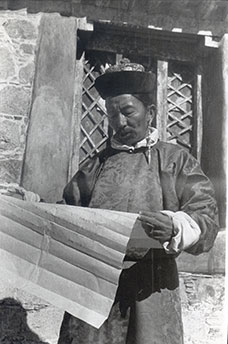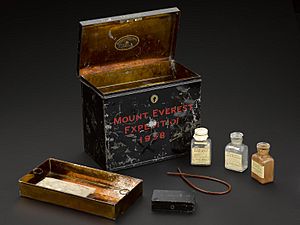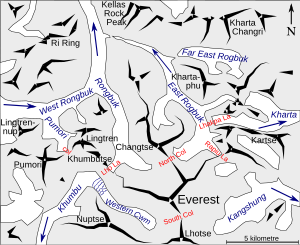1938 British Mount Everest expedition facts for kids
The 1938 British Mount Everest expedition was an attempt to climb Mount Everest, the world's highest mountain. It was led by Bill Tilman. This expedition was planned to be smaller and cost less money than previous ones. Unfortunately, the team faced a very early monsoon (a season of heavy rain and wind), which made it impossible to reach the summit. However, they did achieve some important things. They climbed the North Col from a new direction (the west) for the first time. They also reached a high point of 27,200 feet (8,300 m) on the North Ridge.
Contents
Why This Expedition Was Different
After a previous attempt to climb Everest in 1936 didn't succeed, the group in charge, the Mount Everest Committee, decided not to ask the public for money again. People and newspapers weren't as interested in these expeditions anymore. Also, times were tough, and big expeditions seemed too expensive.
However, a newspaper called The Times offered some money. This was perfect for climbers like Eric Shipton and Bill Tilman. They believed in smaller, simpler expeditions, just like their trip in 1935. In February 1937, Tilman was chosen to lead the expedition. Tom Longstaff, a climber and doctor from the 1922 Everest expedition, gave £3,000. He had one condition: there should be no early news stories, and climbers should try to pay their own way if they could.
Getting Ready for the Climb
Besides Tilman and Shipton, other skilled climbers joined the team. These included Frank Smythe, Noel Odell, Peter Lloyd, Peter Oliver, and Charles Warren. Ang Tharkay was the sirdar, which means he was the main leader for the Sherpas. Tenzing Norgay, who later became very famous for reaching the summit in 1953, was also one of the Sherpas on this trip. Another climber, Jack Longland, was invited but couldn't come because his job wouldn't give him time off.
The team was very strong and got along well. Tilman thought seven climbers might be too many, but he agreed, saying it gave them a good safety margin. The whole trip was planned to cost only £2,360, which was much less than the £10,000 spent in 1936. They didn't bring radios because Tilman thought they weren't needed. However, he was convinced to bring oxygen equipment. The food was very simple, with Tilman even calling soup and porridge "goodies."
The Journey and Challenges
The team arrived in Gangtok, Sikkim, on March 3, 1938. They then crossed into Tibet, hoping to reach Rongbuk before the monsoon season began. It was still very cold, and there was deep snow on their journey. But they reached Rongbuk on April 6, which was earlier than any other team had managed before. Mount Everest looked clear of snow. Forty-five Sherpas joined them, coming from Nepal.
The climbers took the usual path up the East Rongbuk Glacier. They set up Camp III at the end of the glacier. However, it was too cold to try climbing up to the North Col. Most of the climbers were feeling unwell because of the extreme cold. Shipton and Smythe, who were expected to try for the summit, had been sent to a warmer valley to recover. The rest of the team soon joined them there for a week to get better in the springtime weather.
When they returned to Rongbuk, they found it had been snowing for a week. The monsoon had started on May 5, which was three weeks earlier than expected from previous expeditions. They went back to Camp III and, on May 18, climbed to the North Col with surprising ease. Shipton and Smythe rejoined them. Heavy snow fell that night, and it wasn't until May 24 that they could set up Camp IV on the North Col. It was warm there, but the snow was deep. They realized they would have to try for the summit during the monsoon.
Tilman decided to split the team. Shipton, Smythe, and Lloyd went to the main Rongbuk Glacier to try to reach the North Col from the west. The others stayed at Camp IV. Tenzing led the way up the North Ridge, but the snow was so deep that Tilman decided not to even try to set up Camp V. Even more snow forced them to go back to Camp III. Tilman then joined the western team.
The western team eventually reached the North Col from the west. This was the first time anyone had reached the Col from that side, even though the snow made it dangerous. On the North Ridge, they managed to set up Camp VI at 27,200 feet (8,300 m). But beyond that, the conditions were almost impossible. Shipton, Smythe, Tilman, and Lloyd could only climb a little higher than the camp. In the end, they decided to go back down the mountain. Tenzing and Pasang Bhotia had climbed incredibly well up to Camp VI. However, Pasang had a stroke at the North Col, which made him unable to move his right side and confused him. He had to be carried down the mountain, but he later recovered quite well.
One of the climbers, Oliver, returned ahead of the others. He stayed with Norman Odling, who had helped climbers on previous trips. But Oliver didn't know that Odling was also a reporter. Odling reported the story he had been told, and The Times newspaper was upset because they didn't get the news first.
What They Achieved
This expedition showed that a small team might have just as good a chance of reaching the summit as a large one. However, it also proved that the monsoon season was not a good time to try to climb Everest from the north (Tibetan) side.
The Sherpas on this trip showed how much their climbing skills had improved. For the first time, they were able to take a leading role, even encouraging the European climbers to keep going higher.
They tried using a new type of oxygen equipment, but it didn't work well because climbers felt like they couldn't breathe. However, another type of oxygen system, called an open-circuit design, was found to be very helpful above 26,000 feet (7,900 m). This knowledge, especially from George Finch who had supported this type of oxygen, was later used to plan the successful 1953 expedition.
The climbers returned to Europe as the world was heading towards World War II. The Mount Everest Committee asked for permission to climb again in 1941, 1942, and 1943, but this didn't happen. After the war, the Dalai Lama didn't respond to requests, and then in 1950, Tibet's borders were closed when China took control of Tibet. So, after the war, British Everest attempts had to be made from Nepal to the south.
|




